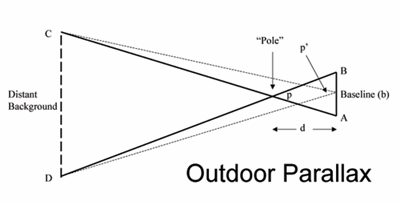 The Sun, Moon, stars and other celestial objects are beyond the reach of any instrument that can be used by observers here on Earth. Measuring the distance of a celestial object from the Earth might seem to be complicated. But measuring the distance of these remote entities have been simplified by the concept of parallax. This term is often used relating to optical instruments like binoculars and microscopes. Visualizing a parallax can be easily done by placing the thumb in one’s line of sight and view a distant object using one eye at a time. A distant object seems to shift location when the observer switches from one eye to another.
The Sun, Moon, stars and other celestial objects are beyond the reach of any instrument that can be used by observers here on Earth. Measuring the distance of a celestial object from the Earth might seem to be complicated. But measuring the distance of these remote entities have been simplified by the concept of parallax. This term is often used relating to optical instruments like binoculars and microscopes. Visualizing a parallax can be easily done by placing the thumb in one’s line of sight and view a distant object using one eye at a time. A distant object seems to shift location when the observer switches from one eye to another.
Parallax provides astronomers with a simple method of calculating the distance of many celestial objects. As the Earth revolves around the Sun, celestial objects seem to be located at different positions when observed month after month. When a star is observed during June and December, observers can make use of two different viewpoints or lines of sight to the star to measure the distance. These two lines of sight intersect at the star being observed, forming an angle and half of this angle is the parallax. Typically, the distance is measured in parsecs by getting the inverse of the observed parallax measured in arc seconds.
There are different kinds of parallax, namely, stellar, solar, lunar, diurnal, and dynamic or moving cluster. It is important to keep in mind that parallax decreases with distance and can only be used to measure celestial objects at a maximum distance of 100 parsecs. The use of this concept in astronomy is extended with much precision through the use of the Hipparcos satellite.
Geometric Technique – Parallax
